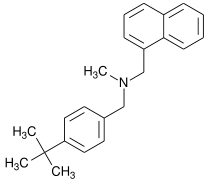- Butenafine
-
Butenafine 
Systematic (IUPAC) name [(4-tert-butylphenyl)methyl](methyl)(naphthalen-1-ylmethyl)amine Clinical data Trade names Mentax AHFS/Drugs.com monograph Pregnancy cat. ? Legal status ? Routes topical Pharmacokinetic data Metabolism Hepatic Half-life 35-100 hours Identifiers CAS number 101828-21-1 ATC code D01AE23 PubChem CID 2484 DrugBank APRD00833 ChemSpider 2390 
UNII 91Y494NL0X 
KEGG D07596 
ChEBI CHEBI:3238 
ChEMBL CHEMBL990 
Chemical data Formula C23H27N Mol. mass 317.47 g/mol SMILES eMolecules & PubChem  (what is this?) (verify)
(what is this?) (verify)Butenafine hydrochloride is a synthetic benzylamine antifungal, marketed under the trade names Mentax, Butop (India) and is the active ingredient in Schering-Plough's Lotrimin Ultra. It is structurally related to synthetic allylamine antifungals such as terbinafine.
Pharmacology
Butenafine hydrochloride is an odorless white crystalline powder that is freely soluble in methanol, ethanol, and chloroform, and slightly soluble in water.
Like the allylamine antifungals, butenafine works by inhibiting the synthesis of ergosterol by inhibiting squalene epoxidase, an enzyme responsible for the creation of sterols needed in fungal cell membranes. Lacking ergosterol, the cell membranes increase in permeability, allowing their contents to leak out.
Indications
Butenafine is indicated for the topical treatment of tinea (pityriasis) versicolor due to M. furfur, as well as athlete’s foot (Tinea pedis), ringworm (Tinea corporis) and jock itch (Tinea cruris) due to E. floccosum, T. mentagrophytes, T. rubrum, and T. tonsurans. It has superior fungicidal activity against this group of fungi when compared to that of terbinafine, naftifine, clotrimazole, and tolnaftate.
It also displays superior activity against Candida albicans when compared against terbinafine and naftifine. Butenafine demonstrates low minimum inhibitory concentrations against cryptococcus and aspergillus.
Butenafine is typically available as a 1% topical cream.
Typical usage
For 1% cream
- for adults and children 12 years and older
- wash the affected skin with soap and water and dry completely before applying
- apply once a day to affected skin for 2 weeks or as directed by a doctor
- wash hands after each use
- children under 12 years: ask a doctor
Antifungals (D01 and J02) Wall/
membranetopical: Bifonazole, Clomidazole, Clotrimazole#, Croconazole, Econazole, Fenticonazole, Ketoconazole, Isoconazole, Miconazole#, Neticonazole, Oxiconazole, Sertaconazole, Sulconazole, Tioconazoletopical: (Fluconazole#, Fosfluconazole)
systemic: (Fluconazole, Hexaconazole, Itraconazole, Posaconazole, Voriconazole)topical: ThiabendazoleIntracellular Others Bromochlorosalicylanilide • Methylrosaniline • Tribromometacresol • Undecylenic acid • Polynoxylin • Chlorophetanol • Chlorphenesin • Ticlatone • Sulbentine • Ethyl hydroxybenzoate • Haloprogin • Salicylic acid • Selenium sulfide# • Ciclopirox • Amorolfine • Dimazole • Tolnaftate • Tolciclate • Sodium thiosulfate# • Whitfield's ointment# • Potassium iodide#
Tea tree oil • citronella oil • lemon grass • orange oil • patchouli • lemon myrtle
PCP: Pentamidine • Dapsone • Atovaquone
This antiinfective drug article is a stub. You can help Wikipedia by expanding it. This dermatologic drug article is a stub. You can help Wikipedia by expanding it.
